SeahorseKeeper
Where's the mysis?
View BadgesStaff member
Super Moderator
Excellence Award
Article Contributor
NJRC Member
Hospitality Award
[h=1]Intro to Keeping Seahorses by Krista Guogas[/h]
You have decided that you would like to keep seahorses in your aquarium. Awesome! I find that keeping seahorses is relatively easy to do, especially considering all the information that we have available.
The first thing you need to do is decide on which variety of seahorses that you would like to keep. Each species has individual needs that you must meet in order to be successful.
Here are some common species that are commonly seen in the home aquarium and their habitat needs:
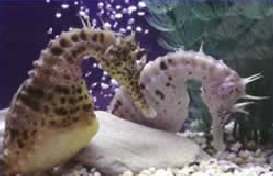 · H. abdominalis (pot belly seahorses)-Temp.: 59-61 degrees Fahrenheit. Tank size: at least 36†vertical height. These seahorses can get up to 12†long and do much better in larger tanks.
· H. abdominalis (pot belly seahorses)-Temp.: 59-61 degrees Fahrenheit. Tank size: at least 36†vertical height. These seahorses can get up to 12†long and do much better in larger tanks.
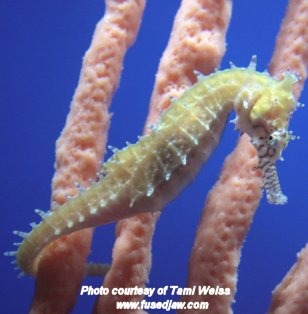 · H. barbouri (Barbor’s seahorse) - Temp.: 72-77 degrees Fahrenheit. Tank size: 20 gallons for a pair or 30 gallons for 2 pairs. These horses only get to be about 6†so they are a perfect candidate for a smaller tank.
· H. barbouri (Barbor’s seahorse) - Temp.: 72-77 degrees Fahrenheit. Tank size: 20 gallons for a pair or 30 gallons for 2 pairs. These horses only get to be about 6†so they are a perfect candidate for a smaller tank.
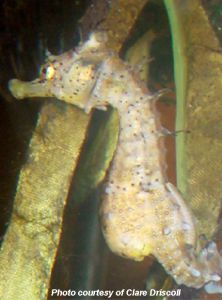 · H. breciveps (short snouted seahorse) – Temp.: 65-69 degrees Fahrenheit. Tank size: 15-20 gallons for a pair and 30 gallons for 2 pair. These horses get to be around four inches and make an ideal seahorse for a smaller tank.
· H. breciveps (short snouted seahorse) – Temp.: 65-69 degrees Fahrenheit. Tank size: 15-20 gallons for a pair and 30 gallons for 2 pair. These horses get to be around four inches and make an ideal seahorse for a smaller tank.
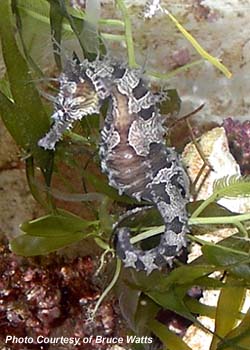 · H. erectus (lined seahorse) – Temp.: 72 to 77 degrees Fahrenheit. Tank size: 25 for a pair and 40 for 2 pair. These horses get to be about 7†and benefit from a tank that has more vertical height as opposed to width.
· H. erectus (lined seahorse) – Temp.: 72 to 77 degrees Fahrenheit. Tank size: 25 for a pair and 40 for 2 pair. These horses get to be about 7†and benefit from a tank that has more vertical height as opposed to width.
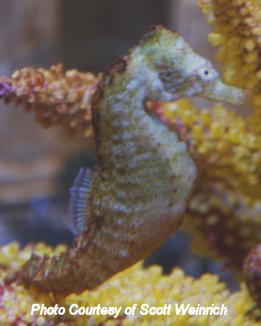 · H.fuscus (sea pony) – Temp.: 72 to 77 degrees Fahrenheit. Tank size: : 15-20 gallons for a pair and 30 gallons for 2 pair. These seahorses typically get to be about 3-5 inches and are also good for small tanks.
· H.fuscus (sea pony) – Temp.: 72 to 77 degrees Fahrenheit. Tank size: : 15-20 gallons for a pair and 30 gallons for 2 pair. These seahorses typically get to be about 3-5 inches and are also good for small tanks.
 · H. ingens (Pacific seahorse) – Temp.: 68-72 degrees Fahrenheit. Tank size: 30 gallons for a pair and 50 gallons for 2 pair. These horses can get up 12â€.
· H. ingens (Pacific seahorse) – Temp.: 68-72 degrees Fahrenheit. Tank size: 30 gallons for a pair and 50 gallons for 2 pair. These horses can get up 12â€.
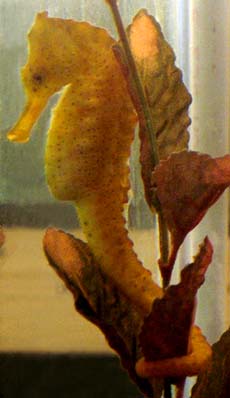 · H. kuda (spotted seahorse) – Temp.: 69-77 degrees Fahrenheit. Tank size: 30 gallons for a pair and 40 for two pair. These horses need a tall tank with at least 30†vertical height since they can get to be 9†or taller.
· H. kuda (spotted seahorse) – Temp.: 69-77 degrees Fahrenheit. Tank size: 30 gallons for a pair and 40 for two pair. These horses need a tall tank with at least 30†vertical height since they can get to be 9†or taller.
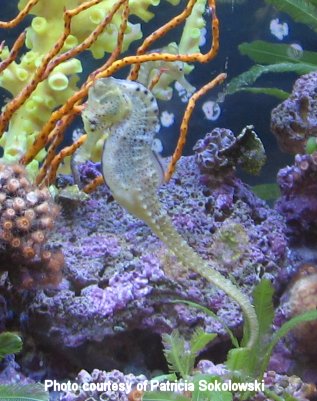 · H. reidi (Brazilian seahorse) – Temp.: 72 to 77 degrees Fahrenheit. Tank size: 25 for a pair and 40 for 2 pair. They can get up to 8†tall and benefit from a tank that is at least 18†tall.
· H. reidi (Brazilian seahorse) – Temp.: 72 to 77 degrees Fahrenheit. Tank size: 25 for a pair and 40 for 2 pair. They can get up to 8†tall and benefit from a tank that is at least 18†tall.
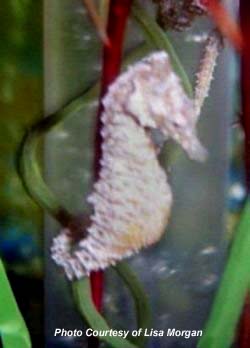 · H. zosterae (dwarf seahorses) - Temp.: 72 to 77 degrees Fahrenheit. Tank size: These horses need nano tanks. They do best in tanks ranging from 2-5 gallons. However, if you plan on keeping quite a few they can be housed in a larger tank. These horses only get to be about 1.5â€.This information and pictures were gathered from seahorsesource.com.
· H. zosterae (dwarf seahorses) - Temp.: 72 to 77 degrees Fahrenheit. Tank size: These horses need nano tanks. They do best in tanks ranging from 2-5 gallons. However, if you plan on keeping quite a few they can be housed in a larger tank. These horses only get to be about 1.5â€.This information and pictures were gathered from seahorsesource.com.
As you can see, not all seahorses are created equal. Each species has its own tank size requirement. This is why I recommend researching which type of seahorse to get before the tank. It is not recommended to mix seahorses from different species. It is possible that horses from different species can introduce bacteria/diseases to one another.
Once you have decided on the seahorse species, you can decide on the tank. I do not recommend all in one tanks such as the Biocube. These tanks generate a lot of heat. Seahorses thrive in cooler tanks and the all in ones are not that conducive to that. Also, you want to take into consideration the height of the tank. Many of the seahorse varieties that are listed above prefer a tank that is more vertical. Seahorses are not open water swimmers and are typically found in grassy lagoons or shallow waters. You want to replicate this by getting a taller tank. This will also help encourage their courting dances. I recommend getting a tank that is at least 24†tall.
Now that you have a tank, the next thing you need to focus on is maintaining the proper tank temperature. Seahorses thrive in tanks that are kept at a stable temperature and cooler than a typical reef tank. Even though some of the recommended temperatures I listed is 77, I recommend keeping a seahorse tank no warmer than 75. Seahorses are prone to bacterial infections and other diseases if the tank is kept too warm. Chillers are an important part of equipment needed to keep seahorses long term. It is important to get one that is appropriately rated for the tank size. For larger tanks or tanks that require temps in the 60’s, I recommend getting a larger chiller. This will help increase the effectiveness of the chiller and the longevity. Also, for the cooler tanks I recommend insulating the display tank and the sump if applicable. This will help keep the tank cooler and help prevent condensation.
As for filtration, it is very similar to a typical saltwater tank. If you can run a sump, that would be awesome. However, you can use a canister filter or HOB filter. The important thing to remember is to keep the intakes covered. Seahorses love to hitch their tails on anything in the tank. It would be very easy for them to injure their tail on an intake. The same goes for power heads. Also, you can run carbon in a seahorse tank, but do not use chemi pure elite or anything that contains ferric oxide. This substance is dangerous to seahorses.
Now for water circulation and aeration, I recommend using an air pump with open ended airline tubing. This makes it so that big bubbles are produced. The horses love to play in the bubbles and it creates a gentle flow. You can have low rated power heads, but you want to ensure the seahorses do not get blasted with flow. This is important because seahorses are not strong swimmers and will get thrashed around in high flow tanks.
Other equipment that I recommend is lights, thermometer, controller, clip on fans and good test kits that you trust. The lights depend on what you want, just like any other tank. I do not recommend halides due to the heat, but if you have a chiller that should not be issue. The thermometer and controller go hand in hand to ensure that the temperature is properly maintained. I like clip on fans that attached to the tank to provide a decent transfer of the heat generated by the lights. Test kits are important to make sure the water quality is properly monitored.
Now, it is time to begin setting up your seahorse tank. The substrate that I prefer is sand. The type of sand that you want to use is up to you. Personally, I am not a fan of crushed coral, but that is another debate for another time.
Next up is the rock work. I prefer to use dry rock. Live rock to me is just too scary to use for a sea horse tank. It can come with unwanted hitchhikers that can harm the seahorses. Another idea that you can do for the rock work is a foam rock wall. This is advantageous because it provides more swimming room for the seahorses.
Remember how I said that seahorses come from grassy lagoons? Well, this is important because seahorses need areas where they can hitch, just like they would to the blades of sea grass in the lagoons. You can incorporate macroalgae into the aquascape. You can provide seahorse friendly corals or even fake decorations, such as plastic plants (ensure they are metal free), so that they can hitch.
Now, you are ready to cycle the tank. The most common methods are to add pure ammonia to the tank or to use a piece of shrimp. I recommend to each hobbyist to research each way and do what they are most comfortable with. I recommend cycling a seahorse tank longer than a typical saltwater tank. I ghost feed the tank heavily after the initial cycle and monitor my ammonia levels. Once they are consistently at zero, I will add my first introductions to the tank.
My first introductions are typically the first batch of the CUC as well as my first fish. It is important when choosing your inhabitants that you choose wisely. Seahorses are docile fish and need to be kept with fish that are docile as well. Seahorse.org has some great info that you can use to research potential inhabitants. For the CUC, I keep peppermint shrimp and a variety of snails. I also like to add copepods and amphipods to the tank in the beginning stages as well. The seahorses will hunt the amphipods.
Many seahorse keepers choose to have macroalgae in the display tank. I encourage this 100%. The macroalgae will serve an important role in the nutrient export in the tank, since the seahorses are messy eaters. The macros will provide hitches and hiding places for the horses. Also, the seahorses come from areas where macros are abundant.
Seahorse tanks can have corals in them. However, it is important to choose seahorse friendly corals. These would be corals that do not sting and are not aggressive. Gorgians, star polyps, anthelia, leather corals, ricordia, sun coral, and zoas are among some of the corals that would go great with seahorses.
OK, you have made it this far now is the time to get the seahorses. I recommend getting seahorses from a reputable breeder such as seahorsesource.com. I encourage hobbyists to get captive bred horses. Wild caught horses do not have good success rates, need to be dewormed and just do not adapt well to the home aquarium. Also, I recommend getting seahorses from the same source. This helps reduce the chance of introducing diseases to the horses from different breeders.
What do seahorses eat? Seahorses will eat amhipods, brine shrimp and mysis shrimp in the home aquarium. Dwarf seahorses only eat live foods. It is possible to train many seahorses to eat from a feeding dish. It is helpful to have hitches available around the dish to encourage them to hitch around the feeding dish.
Another, thing to have handy is an emergency kit. I have Biobandage, furan 2, malachite green, syringes, and a cannula. These are just some basic things that are available in LFS’s or online. I have difficulty getting certain things locally, so I order them online. I also have a quarantine tank available with equipment. This helps to ensure that you are prepared in the event of an emergency.
Now, this sums up the basics that pertain to caring for seahorses. The most important thing that I can stress to a person thinking about caring for seahorses is to take their time. It is important to take the tank and its setup slowly. The information included in this article is just the basics.
Special Thanks to Seahorse.com for allowing me to use information from their website.
You have decided that you would like to keep seahorses in your aquarium. Awesome! I find that keeping seahorses is relatively easy to do, especially considering all the information that we have available.
The first thing you need to do is decide on which variety of seahorses that you would like to keep. Each species has individual needs that you must meet in order to be successful.
Here are some common species that are commonly seen in the home aquarium and their habitat needs:









As you can see, not all seahorses are created equal. Each species has its own tank size requirement. This is why I recommend researching which type of seahorse to get before the tank. It is not recommended to mix seahorses from different species. It is possible that horses from different species can introduce bacteria/diseases to one another.
Once you have decided on the seahorse species, you can decide on the tank. I do not recommend all in one tanks such as the Biocube. These tanks generate a lot of heat. Seahorses thrive in cooler tanks and the all in ones are not that conducive to that. Also, you want to take into consideration the height of the tank. Many of the seahorse varieties that are listed above prefer a tank that is more vertical. Seahorses are not open water swimmers and are typically found in grassy lagoons or shallow waters. You want to replicate this by getting a taller tank. This will also help encourage their courting dances. I recommend getting a tank that is at least 24†tall.
Now that you have a tank, the next thing you need to focus on is maintaining the proper tank temperature. Seahorses thrive in tanks that are kept at a stable temperature and cooler than a typical reef tank. Even though some of the recommended temperatures I listed is 77, I recommend keeping a seahorse tank no warmer than 75. Seahorses are prone to bacterial infections and other diseases if the tank is kept too warm. Chillers are an important part of equipment needed to keep seahorses long term. It is important to get one that is appropriately rated for the tank size. For larger tanks or tanks that require temps in the 60’s, I recommend getting a larger chiller. This will help increase the effectiveness of the chiller and the longevity. Also, for the cooler tanks I recommend insulating the display tank and the sump if applicable. This will help keep the tank cooler and help prevent condensation.
As for filtration, it is very similar to a typical saltwater tank. If you can run a sump, that would be awesome. However, you can use a canister filter or HOB filter. The important thing to remember is to keep the intakes covered. Seahorses love to hitch their tails on anything in the tank. It would be very easy for them to injure their tail on an intake. The same goes for power heads. Also, you can run carbon in a seahorse tank, but do not use chemi pure elite or anything that contains ferric oxide. This substance is dangerous to seahorses.
Now for water circulation and aeration, I recommend using an air pump with open ended airline tubing. This makes it so that big bubbles are produced. The horses love to play in the bubbles and it creates a gentle flow. You can have low rated power heads, but you want to ensure the seahorses do not get blasted with flow. This is important because seahorses are not strong swimmers and will get thrashed around in high flow tanks.
Other equipment that I recommend is lights, thermometer, controller, clip on fans and good test kits that you trust. The lights depend on what you want, just like any other tank. I do not recommend halides due to the heat, but if you have a chiller that should not be issue. The thermometer and controller go hand in hand to ensure that the temperature is properly maintained. I like clip on fans that attached to the tank to provide a decent transfer of the heat generated by the lights. Test kits are important to make sure the water quality is properly monitored.
Now, it is time to begin setting up your seahorse tank. The substrate that I prefer is sand. The type of sand that you want to use is up to you. Personally, I am not a fan of crushed coral, but that is another debate for another time.
Next up is the rock work. I prefer to use dry rock. Live rock to me is just too scary to use for a sea horse tank. It can come with unwanted hitchhikers that can harm the seahorses. Another idea that you can do for the rock work is a foam rock wall. This is advantageous because it provides more swimming room for the seahorses.
Remember how I said that seahorses come from grassy lagoons? Well, this is important because seahorses need areas where they can hitch, just like they would to the blades of sea grass in the lagoons. You can incorporate macroalgae into the aquascape. You can provide seahorse friendly corals or even fake decorations, such as plastic plants (ensure they are metal free), so that they can hitch.
Now, you are ready to cycle the tank. The most common methods are to add pure ammonia to the tank or to use a piece of shrimp. I recommend to each hobbyist to research each way and do what they are most comfortable with. I recommend cycling a seahorse tank longer than a typical saltwater tank. I ghost feed the tank heavily after the initial cycle and monitor my ammonia levels. Once they are consistently at zero, I will add my first introductions to the tank.
My first introductions are typically the first batch of the CUC as well as my first fish. It is important when choosing your inhabitants that you choose wisely. Seahorses are docile fish and need to be kept with fish that are docile as well. Seahorse.org has some great info that you can use to research potential inhabitants. For the CUC, I keep peppermint shrimp and a variety of snails. I also like to add copepods and amphipods to the tank in the beginning stages as well. The seahorses will hunt the amphipods.
Many seahorse keepers choose to have macroalgae in the display tank. I encourage this 100%. The macroalgae will serve an important role in the nutrient export in the tank, since the seahorses are messy eaters. The macros will provide hitches and hiding places for the horses. Also, the seahorses come from areas where macros are abundant.
Seahorse tanks can have corals in them. However, it is important to choose seahorse friendly corals. These would be corals that do not sting and are not aggressive. Gorgians, star polyps, anthelia, leather corals, ricordia, sun coral, and zoas are among some of the corals that would go great with seahorses.
OK, you have made it this far now is the time to get the seahorses. I recommend getting seahorses from a reputable breeder such as seahorsesource.com. I encourage hobbyists to get captive bred horses. Wild caught horses do not have good success rates, need to be dewormed and just do not adapt well to the home aquarium. Also, I recommend getting seahorses from the same source. This helps reduce the chance of introducing diseases to the horses from different breeders.
What do seahorses eat? Seahorses will eat amhipods, brine shrimp and mysis shrimp in the home aquarium. Dwarf seahorses only eat live foods. It is possible to train many seahorses to eat from a feeding dish. It is helpful to have hitches available around the dish to encourage them to hitch around the feeding dish.
Another, thing to have handy is an emergency kit. I have Biobandage, furan 2, malachite green, syringes, and a cannula. These are just some basic things that are available in LFS’s or online. I have difficulty getting certain things locally, so I order them online. I also have a quarantine tank available with equipment. This helps to ensure that you are prepared in the event of an emergency.
Now, this sums up the basics that pertain to caring for seahorses. The most important thing that I can stress to a person thinking about caring for seahorses is to take their time. It is important to take the tank and its setup slowly. The information included in this article is just the basics.
Special Thanks to Seahorse.com for allowing me to use information from their website.


















